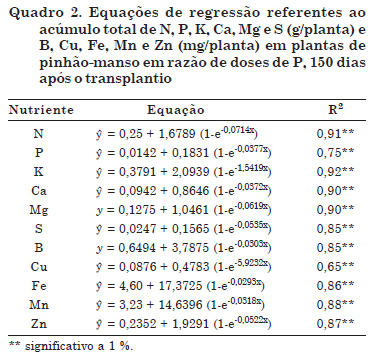Physic nut (Jatropha curcas L.) is a perennial oilseed species that has aroused economic interest for biodiesel production. Among other factors, it is essential to determine the nutritional demands of this species to facilitate raising it as a crop. This study aimed to evaluate the early growth and mineral nutrition of physic nut, as well as soil fertility, as affected by phosphorus fertilization. The study was carried out in a plastic greenhouse in a completely randomized block experimental design with four replicates. The plants were grown in plastic pots filled with 50 dm³ of Latossolo Vermelho (Rhodic Hapludox). Application rates of 0, 50, 100, 150 and 200 mg dm-3 of P were tested, plus a control. Evaluations of plant height and root collar diameter were performed monthly. The experiment was ended 150 days after transplant of the seedlings, at which time leaf area, dry weight, leaf contents and total accumulation of macro- (N, P, K, Ca, Mg and S) and micronutrients (B, Cu, Fe, Mn and Zn) were performed, and soil chemical properties were analyzed. We concluded that absence of P fertilization alone is as limiting to early growth of physic nut as simultaneous absence of soil amendment and fertilization. The rate of 57 mg dm-3 of P may be recommended for initial growth of physic nut. The total accumulation of nutrients in physic nut seedlings exhibited the following order: K>N>Mg>Ca>P>S>Fe>Mn>B>Zn>Cu. Phosphorus fertilization resulted in increased soil cation exchange capacity (CEC).
Jatropha curcas; leaf area; dry matter; macronutrients; micronutrients








